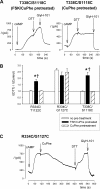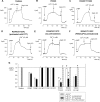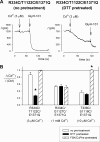Relative movements of transmembrane regions at the outer mouth of the cystic fibrosis transmembrane conductance regulator channel pore during channel gating
- PMID: 22843683
- PMCID: PMC3442544
- DOI: 10.1074/jbc.M112.385096
Relative movements of transmembrane regions at the outer mouth of the cystic fibrosis transmembrane conductance regulator channel pore during channel gating
Abstract
Multiple transmembrane (TM) segments line the pore of the cystic fibrosis transmembrane conductance regulator Cl(-) channel; however, the relative alignment of these TMs and their relative movements during channel gating are unknown. To gain three-dimensional structural information on the outer pore, we have used patch clamp recording to study the proximity of pairs of cysteine side chains introduced into TMs 6 and 11, using both disulfide cross-linking and Cd(2+) coordination. Following channel activation, disulfide bonds could apparently be formed between three cysteine pairs (of 15 studied): R334C/T1122C, R334C/G1127C, and T338C/S1118C. To examine the state dependence of cross-linking, we combined these cysteine mutations with a nucleotide-binding domain mutation (E1371Q) that stabilizes the channel open state. Investigation of the effects of the E1371Q mutation on disulfide bond formation and Cd(2+) coordination suggests that although R334C/T1122C and T338C/S1118C are closer together in the channel open state, R334C/G1127C are close together and can form disulfide bonds only when the channel is closed. These results provide important new information on the three-dimensional structure of the outer mouth of the cystic fibrosis transmembrane conductance regulator channel pore: TMs 6 and 11 are close enough together to form disulfide bonds in both open and closed channels. Moreover, the altered relative locations of residues in open and in closed channels that we infer allow us to propose that channel opening and closing may be associated with a relative translational movement of TMs 6 and 11, with TM6 moving "down" (toward the cytoplasm) during channel opening.
Figures







Similar articles
-
Metal bridges illuminate transmembrane domain movements during gating of the cystic fibrosis transmembrane conductance regulator chloride channel.J Biol Chem. 2014 Oct 10;289(41):28149-59. doi: 10.1074/jbc.M114.593103. Epub 2014 Aug 20. J Biol Chem. 2014. PMID: 25143385 Free PMC article.
-
Alignment of transmembrane regions in the cystic fibrosis transmembrane conductance regulator chloride channel pore.J Gen Physiol. 2011 Aug;138(2):165-78. doi: 10.1085/jgp.201110605. Epub 2011 Jul 11. J Gen Physiol. 2011. PMID: 21746847 Free PMC article.
-
Changes in accessibility of cytoplasmic substances to the pore associated with activation of the cystic fibrosis transmembrane conductance regulator chloride channel.J Biol Chem. 2010 Oct 15;285(42):32126-40. doi: 10.1074/jbc.M110.113332. Epub 2010 Jul 30. J Biol Chem. 2010. PMID: 20675380 Free PMC article.
-
Conformational changes opening and closing the CFTR chloride channel: insights from cysteine scanning mutagenesis.Biochem Cell Biol. 2014 Dec;92(6):481-8. doi: 10.1139/bcb-2014-0038. Epub 2014 Sep 12. Biochem Cell Biol. 2014. PMID: 25367045 Review.
-
Emerging issues of connexin channels: biophysics fills the gap.Q Rev Biophys. 2001 Aug;34(3):325-472. doi: 10.1017/s0033583501003705. Q Rev Biophys. 2001. PMID: 11838236 Review.
Cited by
-
Characterization of Signaling Pathways Associated with Pancreatic β-cell Adaptive Flexibility in Compensation of Obesity-linked Diabetes in db/db Mice.Mol Cell Proteomics. 2020 Jun;19(6):971-993. doi: 10.1074/mcp.RA119.001882. Epub 2020 Apr 7. Mol Cell Proteomics. 2020. PMID: 32265294 Free PMC article.
-
Cysteine scanning of CFTR's first transmembrane segment reveals its plausible roles in gating and permeation.Biophys J. 2013 Feb 19;104(4):786-97. doi: 10.1016/j.bpj.2012.12.048. Biophys J. 2013. PMID: 23442957 Free PMC article.
-
Transmembrane helical interactions in the CFTR channel pore.PLoS Comput Biol. 2017 Jun 22;13(6):e1005594. doi: 10.1371/journal.pcbi.1005594. eCollection 2017 Jun. PLoS Comput Biol. 2017. PMID: 28640808 Free PMC article.
-
Cystic fibrosis transmembrane conductance regulator chloride channel blockers: Pharmacological, biophysical and physiological relevance.World J Biol Chem. 2014 Feb 26;5(1):26-39. doi: 10.4331/wjbc.v5.i1.26. World J Biol Chem. 2014. PMID: 24600512 Free PMC article. Review.
-
Positioning of extracellular loop 1 affects pore gating of the cystic fibrosis transmembrane conductance regulator.Am J Physiol Lung Cell Mol Physiol. 2016 Mar 1;310(5):L403-14. doi: 10.1152/ajplung.00259.2015. Epub 2015 Dec 18. Am J Physiol Lung Cell Mol Physiol. 2016. PMID: 26684250 Free PMC article.
References
-
- O'Sullivan B. P., Freedman S. D. (2009) Cystic fibrosis. Lancet 373, 1891–1904 - PubMed
Publication types
MeSH terms
Substances
Grants and funding
LinkOut - more resources
Full Text Sources
Medical

